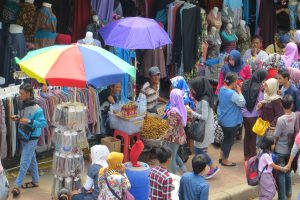Muslim Cosmopolitan Marketplaces Across Southeast Asia
May 10, 2021

The Geylang Serai Foot and Food Heritage Trail was launched on 25 April 2015 as part of Singapore Heritage Fest 2015. Held on the last Saturday of each month since its launch, the heritage trail brings its participants into the heart of the bustling multi-cultural and multi-religious historically Malay neighbourhood. Besides the trail, Geylang Serai is best known for the highly anticipated annual Geylang Serai Ramadan Bazaar that most Singaporeans are familiar with. Not only is this marketplace a treasury of Malay culture, it is a cosmopolitan space for the seamless interaction between Muslim and non-Muslim communities through commercial activity. Such vibrant Muslim markets are scattered all across Southeast Asia and provide business owners as well as patrons of Muslim and non-Muslim faiths opportunities to come together.
NUS Malay Studies Associate Professor Khairuddin Aljunied’s chapter titled ‘Everyday Cosmopolitanism in the Marketplace’ in his 2017 book Muslim Cosmopolitanism: Southeast Asian Islam in Comparative Perspective delves deep into the socio-economic and historical significance of these Muslim markets. By examining the markets’ demographics, the type of communication involved, and the spatial dynamics present, the markets are revealed as zones for establishing peaceful relationships across cultures.
Through Southeast Asian history, Muslim cosmopolitanism has had to endure waves of sweeping change that have swept through the region, such as European colonialism and the arrival of migrant settlers. By remaining steadfast through these periods and adapting to change, the Muslim cosmopolitan paved the way for acceptance and harmony between diverse communities. In the present, as participants in Muslim marketplaces fluidly interact with each other, diversity is normalised in this place of commerce. These interactions diverge from a traditionally Muslim dialogue and allow for the emergence of profitable exchanges.
In essence, these markets facilitate social interactions between Muslims and non-Muslims through the trade of goods and services. As people of different backgrounds engage with each other, cohesion and acceptance are fostered. By directing our attention to these Muslim cosmopolitans, we can uncover how cross-cultural interactions have progressed over time and how marketplaces have encapsulated fragments of history within their boundaries.
Get the book here.
